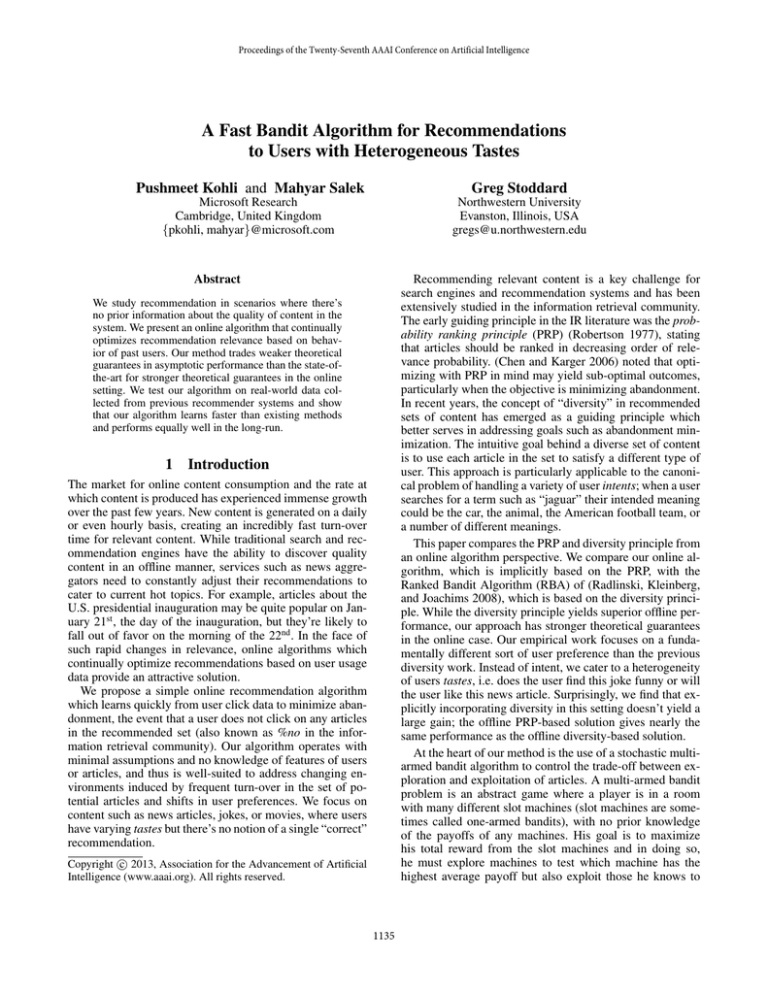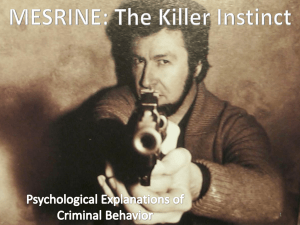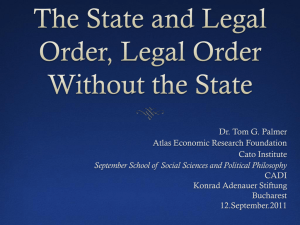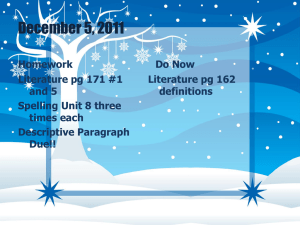
Proceedings of the Twenty-Seventh AAAI Conference on Artificial Intelligence
A Fast Bandit Algorithm for Recommendations
to Users with Heterogeneous Tastes
Pushmeet Kohli and Mahyar Salek
Greg Stoddard
Microsoft Research
Cambridge, United Kingdom
{pkohli, mahyar}@microsoft.com
Northwestern University
Evanston, Illinois, USA
gregs@u.northwestern.edu
Abstract
Recommending relevant content is a key challenge for
search engines and recommendation systems and has been
extensively studied in the information retrieval community.
The early guiding principle in the IR literature was the probability ranking principle (PRP) (Robertson 1977), stating
that articles should be ranked in decreasing order of relevance probability. (Chen and Karger 2006) noted that optimizing with PRP in mind may yield sub-optimal outcomes,
particularly when the objective is minimizing abandonment.
In recent years, the concept of “diversity” in recommended
sets of content has emerged as a guiding principle which
better serves in addressing goals such as abandonment minimization. The intuitive goal behind a diverse set of content
is to use each article in the set to satisfy a different type of
user. This approach is particularly applicable to the canonical problem of handling a variety of user intents; when a user
searches for a term such as “jaguar” their intended meaning
could be the car, the animal, the American football team, or
a number of different meanings.
This paper compares the PRP and diversity principle from
an online algorithm perspective. We compare our online algorithm, which is implicitly based on the PRP, with the
Ranked Bandit Algorithm (RBA) of (Radlinski, Kleinberg,
and Joachims 2008), which is based on the diversity principle. While the diversity principle yields superior offline performance, our approach has stronger theoretical guarantees
in the online case. Our empirical work focuses on a fundamentally different sort of user preference than the previous
diversity work. Instead of intent, we cater to a heterogeneity
of users tastes, i.e. does the user find this joke funny or will
the user like this news article. Surprisingly, we find that explicitly incorporating diversity in this setting doesn’t yield a
large gain; the offline PRP-based solution gives nearly the
same performance as the offline diversity-based solution.
At the heart of our method is the use of a stochastic multiarmed bandit algorithm to control the trade-off between exploration and exploitation of articles. A multi-armed bandit
problem is an abstract game where a player is in a room
with many different slot machines (slot machines are sometimes called one-armed bandits), with no prior knowledge
of the payoffs of any machines. His goal is to maximize
his total reward from the slot machines and in doing so,
he must explore machines to test which machine has the
highest average payoff but also exploit those he knows to
We study recommendation in scenarios where there’s
no prior information about the quality of content in the
system. We present an online algorithm that continually
optimizes recommendation relevance based on behavior of past users. Our method trades weaker theoretical
guarantees in asymptotic performance than the state-ofthe-art for stronger theoretical guarantees in the online
setting. We test our algorithm on real-world data collected from previous recommender systems and show
that our algorithm learns faster than existing methods
and performs equally well in the long-run.
1
Introduction
The market for online content consumption and the rate at
which content is produced has experienced immense growth
over the past few years. New content is generated on a daily
or even hourly basis, creating an incredibly fast turn-over
time for relevant content. While traditional search and recommendation engines have the ability to discover quality
content in an offline manner, services such as news aggregators need to constantly adjust their recommendations to
cater to current hot topics. For example, articles about the
U.S. presidential inauguration may be quite popular on January 21st , the day of the inauguration, but they’re likely to
fall out of favor on the morning of the 22nd . In the face of
such rapid changes in relevance, online algorithms which
continually optimize recommendations based on user usage
data provide an attractive solution.
We propose a simple online recommendation algorithm
which learns quickly from user click data to minimize abandonment, the event that a user does not click on any articles
in the recommended set (also known as %no in the information retrieval community). Our algorithm operates with
minimal assumptions and no knowledge of features of users
or articles, and thus is well-suited to address changing environments induced by frequent turn-over in the set of potential articles and shifts in user preferences. We focus on
content such as news articles, jokes, or movies, where users
have varying tastes but there’s no notion of a single “correct”
recommendation.
c 2013, Association for the Advancement of Artificial
Copyright Intelligence (www.aaai.org). All rights reserved.
1135
3
have high rewards. Similar to (Radlinski, Kleinberg, and
Joachims 2008), the primary contribution of our algorithm is
the method by which we combine instances of several MAB
algorithms to efficiently approximate this combinatorial set
recommendation problem.
1.1
We consider the problem of minimizing abandonment for
an article recommendation system. At the beginning of the
day, n articles are submitted to the system. When a user visits our site, they’re presented with a set of k articles; if the
user finds any of the articles relevant, he clicks on it and we
receive a payoff of 1. If the user finds no articles relevant,
we receive a payoff of 0. We receive no additional payoffs if
the user clicks on more than one article. Each user j can be
represented by a {0, 1}n -vector X j , where a Xij = 1 indicates that the user j finds article i relevant. These relevance
vectors X j are distributed according to some unknown distribution D. These relevance vectors can be thought to represent the type of a user. This type structure allows for a large
degree of correlation between article relevances.
At each time period t, a random user arrives, corresponding to choosing a vector X t i.i.d. from D, and we present
a set of k articles S t . Let F (S t , X t ) denote the payoff for
showing set S t to a user with relevance vector X t . We’ll refer F as the set relevance function and it has the following
form
1 if Xit = 1 for some i ∈ S t
F (S t , X t ) =
(1)
0 otherwise
Our Contributions
We present an online algorithm for the minimization of
abandonment. Our method uses several instances of a multiarmed bandit algorithm working (almost) independently to
recommend a set of articles. Although the independence between bandit instances carries all the drawbacks of the PRP,
we use a stochastic optimization concept known as the correlation gap (Agrawal et al. 2010) to prove that our algorithm has near-optimal performance in the online setting.
Furthermore, the independence between bandit instances allows for a faster learning rate than online algorithms based
on the diversity principle. Our second contribution is an empirical study of bandit-based recommendation algorithms on
real-world datasets collected from previous recommendation algorithm research. We find that while in theory the
diversity-based solutions yield superior offline solutions, in
practice there are only small differences between the offline diversity-based solution and the offline PRP-based solution. We also empirically verify that the learning rate of
our method is faster than that of existing methods.
2
Problem Formalization
The user’s relevance vector X t is not observed before the
algorithm the set is chosen. Thus the value of displaying a set
S t is the expected value E[F (S t , X)] where the expectation
is taken over the realization of the relevance vector X from
the distribution D. When it is clear, we will write E[F (S)]
as shorthand for E[F (S, X)]. In words, E[F (S)] is the fraction of users who will be satisfied by at least one article in
S. The problem of minimizing abandonment is equivalent
to the problem of maximizing E[F (S)] subject to |S| ≤ k.
For the remainder of this paper, we’ll focus on maximizing
expected set relevance E[F (S)].
Before turning to the online version of this problem, we
consider optimization in the offline setting. In the offline setting, an algorithm would have access to the distribution but
even with such assumptions the problem is NP-hard1 Despite this intractability, we can take advantage of the structure of F (S), namely that it is submodular, and use the
greedy algorithm of (Nemhauser, Wolsey, and Fisher 1978).
This yields a (1 − 1e ) approximation, which is the best possible approximation under complexity theoretic assumptions.
(Chen and Karger 2006) argue this greedy approach yields
an optimally diverse set of articles.
A set function G is said to be submodular if, for all elements a and sets S, T such that S ⊆ T , G(S ∪ a) − G(S) ≥
G(T ∪ a) − G(T ). The set relevance function F (S, X), as
defined in equation 1, is submodular and this property forms
the theoretical basis for the online approaches given in the
next section.
Previous Work
Previous work in information retrieval and machine learning has addressed recommendation to heterogenous populations via the goal of maximizing diversity in search results but the literature varies widely in modeling assumptions. In some work, diversity refers to increasing the set
of topics that a recommended set of articles or search results may cover (Agrawal et al. 2009) and (Panigrahi et al.
2012). Other works assume users intrinsically value diversity; (Raman, Shivaswamy, and Joachims 2012) and (Yue
and Guestrin 2011) both assume a rich feature model and use
online learning techniques to learn user utility functions. (Li
et al. 2010) give an online approach for news recommendation using a user’s profile as a feature vector. (Chen and
Karger 2006) prove in a general sense that the standard submodular greedy algorithm is the optimal way to incorporate
diversity into search result rankings.
By contrast, our work carries little assumptions. In this
sense, our work is closer to the literature on online stochastic submodular maximization, particularly in the bandit setting. (Calinescu et al. 2011) prove that a continuous version
of the standard submodular greedy algorithm yields an optimal approximations for all matroid constraints and (Streeter,
Golovin, and Krause 2009) give a similar method (though
less general) which can be extended to the online setting.
The work most closely related to ours is (Radlinski,
Kleinberg, and Joachims 2008) and (Slivkins, Radlinski, and
Gollapudi 2010), although the latter work makes strong use
of a similarity measure between documents whereas we assume no such construct. Their “ranked bandit algorithm”
serves as our baseline in this paper and we discuss the relationships between our methods in later sections.
1
This can be shown by a standard reduction from the max coverage problem. See (Radlinski, Kleinberg, and Joachims 2008) for
details.
1136
4
The Online Problem
Algorithm 1 Ranked Bandit
We now turn to the online version of this problem, which
presents a classic explore-exploit tradeoff: we must balance
the need to learn the average relevance of articles with no
feedback against the need to exploit the good articles that
we’ve already discovered. We solve this problem using theoretical results from the multi-armed bandit (MAB) literature,
a class of algorithms which solve exploration-exploitations
problems. Bandit problems can be distinguished by the assumptions made on the rewards. In the stochastic bandit
problem, rewards for each option are drawn from a stationary distribution while in the adversarial setting, payoffs for
each option are determined by an adversary who has knowledge of past play, history of rewards, and the strategy that
the player is using.
The objective of an online algorithm is the minimization
of regret, where the regret of an algorithm is defined as the
expected difference between the accumulated rewards of the
single best option and the rewards accumulated by that algorithm. In our context, this is the difference between the fraction of users satisfied by the optimal set of articles and the
fraction of users satisfied by the recommendation algorithm.
However, as we noted in the previous section, maximization of E[F (S)] is intractable, so we follow the approach of
(Streeter, Golovin, and Krause 2009) and (Radlinski, Kleinberg, and Joachims 2008) and use (1− 1e )OP T as the offline
benchmark. The regret after time t is defined as
1: MABi : Bandit algorithm for slot i
2: for t = 1...T do
3:
si ← selectArticle(MABi , N)
4:
S t ← ∪i si
5:
Display S t to user, receive feedback vector X t
6:
Feedback:
1 if article si was the first click
zi =
0 otherwise
7:
update(MABi , zi )
8: end for
While RBA works with any bandit algorithm, the regret
of RBA depends on the choice of bandit algorithm. (Radlinski, Kleinberg, and Joachims 2008) use an adversarial bandit algorithm known as EXP3 in their work and show that
RBA inherits the regret bounds guaranteed by EXP3. However the adversarial assumption is overly pessimistic in this
problem and ideally we could make use of the stochastic nature of user behavior. Stochastic bandit algorithms such as
UCB1 have better theoretical and practical performance but
the dependence between slots in RBA violates the necessary independence assumptions for the stochastic setting. In
their work, (Radlinski, Kleinberg, and Joachims
2008) show
p
RBA to have regret on the order of O(k T n lg(n)). Our
approach, discussed in the next section, is able to leverage
the stochastic nature of the problem without complication
and thus achieves a provable regret of O(kn lg(T )).
In addition to the lack of theoretical guarantees, the learning rate of RBA can be quite slow because of “wrong” feedback. The “correct” value of an article in slot i + 1 is the
marginal value of that article given that slots 1 to i are displaying the “correct” articles, that is the first i articles in
the greedy solution. In any time period where those articles
aren’t displayed, the marginal value of any article in slot i+1
will not necessarily be correct. Although early slots should
display the correct articles most of the time, later slots can’t
begin learning correctly until the earlier slots converge. This
effectively induces sequential learning across slots and back
of the envelope calculations suggest that “correct” learning
will only begin in slot k + 1 after Ω(nk ), time steps have
past.
T
T
X
1 X
E[F (S t )]
E[F (S ∗ )] −
R(T ) = (1 − )
e t=0
t=0
There are known bandit algorithms which achieve
provably-minimal regret (up to constant factors), but direct
application of these bandit algorithms requires exploring all
possible options at least once. In our setting, each subset
of articles is a potential option and hence there are exponentially many options, making standard MAB algorithms
impractical. In the next section we present two approaches,
one from previous work and our algorithm, for combining
several instances of a bandit algorithm to yield a low-regret
and computationally efficient solution to this recommendation problem.
4.1
Ranked Bandit Approach
The work of (Radlinski, Kleinberg, and Joachims 2008) and
(Streeter, Golovin, and Krause 2009) introduced the “ranked
bandit” algorithm to solve the problem of minimizing abandonment. The pseudocode is given in algorithm 1. The idea
behind the ranked bandit algorithm is to use k instances
of a MAB algorithm to learn the greedy-optimal solution
(which is also the diversity-optimal solution). Specifically,
k instances of a bandit algorithm are created, where bandit i is responsible for selecting the article to be displayed
in slot i. The algorithm is designed such that the bandit in
slot i attempts to maximize the marginal gain of the article
in slot i. In the context of minimizing abandonment, bandit
i attempts to maximize the click-through-rate of the article
in slot i given that the user has not clicked on any earlier
articles.
4.2
Independent Bandit Approach
In this section we describe our method which we call the independent bandit algorithm (IBA) which is implicitly based
on the probability ranking principle. Rather than learning the
marginal values as in the ranked bandit algorithm, the independent bandit algorithm optimizes the click-through-rate of
each slot independently of the other slots. Using tools from
stochastic optimization theory, we prove that the independent bandit algorithm has near-optimal regret and our simulations demonstrate that IBA converges to its offline-optimal
solution much quicker than RBA.
The pseudocode for the independent bandit algorithm is
given in algorithm 2. Line 5 ensures that the bandit algo-
1137
Algorithm 2 Independent Bandit
rithms don’t select the same articles by temporarily removing articles already displayed from the set of potential articles for bandits in later slots. The main difference between
the independent and the ranked bandit algorithm is the feedback; IBA gives a reward of 1 to any article that was clicked
on while RBA only gives a reward of 1 to the first article that
was clicked on. This independence between bandit instances
in IBA allows for learning to happen in parallel, enabling a
faster rate of learning for IBA.
To analyze the regret of IBA, we must first derive an approximation guarantee for what the offline version of the
independent algorithm would compute. The independentoptimal solution consists of the k articles with the highest
click-through-rates. If article relevances were all independent then the independent-optimal solution is the optimal
solution, however the independent-optimal solution will be
sub-optimal when there are correlations between article relevances. We use the correlation gap result of (Agrawal et al.
2010) to show that the independent-optimal solution yields a
(1 − 1e ) approximation to the optimal solution for any distribution over user relevance vectors. The correlation gap is a
concept in stochastic optimization which quantifies the loss
incurred by optimizing under the assumption that all random
variables are independent. Formally let G(S, X) be some
function where S is the decision variable and X is a vector
of {0, 1} random variables, where X is drawn from some arbitrary distribution D. Let DI be the product distribution if
each Xi were an independent bernoulli variable with probability equal to its marginal probability under D. When G is
a nondecreasing, submodular function the correlation gap is
quite small.
1: MABi : Bandit algorithm for slot i
2: for t = 1...T do
3:
S0t = ∅
4:
for i = 1...k do
t
5:
Sit ← selectArticle(MABi , N \ Si−1
)
6:
end for
7:
Display S t to user, receive feedback vector X t
8:
Feedback:
zi =
1 if article si was clicked on
0 otherwise
9:
update(MABi , zi )
10: end for
expected valued of F (S t , X) as follows
E[F (S t )] =
E[F (S t )] =
k i−1
X
Y
(1 − (p∗j − δj ))(p∗i − δi )
i=1 j=1
≥
k i−1
X
Y
(1 − p∗j )(p∗i ) − δi
i=1 j=1
= E[F (SI∗ )] −
X
δi
i
Now taking the sum of the f (S t , X) over time yields
X
X
XX
E[
F (S t , X)] ≥
F (SI∗ ) −
δit
t
Theorem 1. When UCB1 is used as the bandit algorithm
for IBA, the accumulated rewards satisfy
t
(2)
(note, this equation gives the same value for any permutation
of S t ). Let SI∗ denote the set which maximizes the above
function under the assumption that all Xi are independent.
Trivially, this set consists of the k articles with the largest pi .
Label these elements p∗i for i = 1...k. At a given time t let
S t denote the set played and let Sit represent the ith element
of this set. Define δi = p∗i −pi , that is the difference between
the relevance probability of the best article and the relevance
probability of the article actually played at time t.
Now we consider the independent bandit algorithm. The
key property of IBA is that individual bandit instances do not
affect each other and this allows us to prove that IBA inherits
the low regret of the underlying stochastic bandit algorithms,
yielding better regret bounds than RBA. For the purposes of
the next theorem, we use the UCB1 algorithm (details are
given in section 5), which has regret O(n lg(T )).
T
X
(1 − pj )pi
i=1 j=1
Theorem (Agrawal et al. 2010) 1. Let G be a nondecreasing, submodular function. Let S ∗ and SI∗ be the optimizers for ED [G(S, X)] and EDI [G(S, X)] respectively. Then
ED [G(SI∗ , X)] ≥ (1 − 1e )ED [G(S ∗ , X)].
E[
k i−1
X
Y
t
t
t δi
P
i
t
The term
is the regret incurred in slot i. (Auer,
Cesa-Bianchi, and Fischer 2002) proves
P that the regret of
UCB1 is bounded by O(n lg(T )), so t δit ≈ O(n lg(T ))
for each slot.
In the above analysis, we assume that the probability of
an article being relevant was independent of each other Xi ,
which is usually a faulty assumption. However, the work of
(Agrawal et al. 2010) shows that optimizing under the independence assumption yields a provable approximation. Let
S ∗ denote the set which maximizes E[f (S, X)]. Then the
correlation gap implies E[f (SI∗ )] ≥ (1− 1e )E[f (S ∗ )]. Combining this with the above regret bound yields the result
X
1
E[
F (S t , X)] ≥ (1 − )OP T − O(kn lg(T ))
e
t
1
F (S t , X)] ≥ (1 − )OP T − O(kn lg(T ))
e
Proof. The high level is to first show that IBA has low regret when compared with the independent-optimal set. We
then apply the correlation gap of (Agrawal et al. 2010) to
conclude the regret is close to (1 − 1e )OP T .
For a given document displayed in slot i, let pi denote
the marginal probability of relevance, that is pi = EX [Xi ].
Assume for now that all Xi are independent. Using this independence assumption, for a given set S t we can write the
1138
Figure 1: Movie-Lens-100 dataset with relevance threshold
θ = 2, the low threshold. The Ranked-Greedy method
starts performing better after t = 10000 but fails to achieve
the theoretical optimum performance within 100000 time
steps. The Independent-Greedy algorithm achieves its offline optimum after 50000 time steps.
Figure 2: Movie-Lens-100 dataset with relevance threshold
θ = 4, the high threshold. The Independent-Greedy method
performs the best out of all four methods.
users on a sub-sampled set of 100 articles from the MovieLens dataset. For all datasets, we convert real-valued ratings
to binary relevant-or-not scores by using a threshold rule; if
the rating assigned by a user to an article exceeds a threshold
θ, then that article is deemed relevant to that user. For each
dataset, we tested a high and a low threshold for relevance.2
The data we use is of a fundamentally different nature
than the generated by (Radlinski, Kleinberg, and Joachims
2008). In that work, they model user intent, i.e. is a user
that searches for the term “jaguar” talking about the car, the
animal, or some other meaning? In our work, we care about
user taste, i.e. which joke or movie will a user like? In the
case of intent, there’s generally a correct answer and a single
article rarely satisfies multiple types of users. For the case of
taste, there is rarely a single “correct” answer and a single
article may satisfy many different types of users.
Baselines.In our experiments, we used two well-known
stochastic multi-armed bandit algorithms to test the Ranked
Bandit Algorithm and the Independent Bandit Algorithm.
Both algorithms, UCB1 and -Greedy, are examined in detail in (Auer, Cesa-Bianchi, and Fischer 2002) but we briefly
review them here. In each time
q step t, UCB1 plays the opwhere x̄i denotes the
tion which maximizes x̄i + 2 lg(t)
ti
current average reward of option i and ti denotes the number of times that option i has been played so far. The second
term in this equation naturally induces exploration since this
term grows for options that have not been played in a while.
The second MAB algorithm is the -Greedy algorithm.
At each time t, with probability a uniformly random arm is
played, and with probability 1− the option with the current
highest average reward is played. Note that this algorithm
requires the parameter to be tuned; for these experiments,
we set = .05, which proved to give the best average performance during initial tests.
It is worth noting that the independent-optimal solution
is (weakly) worse than the greedy-optimal solution, so RBA
will asymptotically outperform IBA. However, the previous
theorem shows that IBA has the same worst-case guarantee along with a better regret bound that holds uniformly
throughout time. In the next section, we simulate both algorithms using real-world datasets and show that the asymptotic performances of the two methods are essentially equal
but IBA performs better in the short term.
5
Experimental Results
In this section, we give the results of experiments we used
to test the empirical difference in performance between the
ranked bandit algorithm and the independent bandit algorithm.
Datasets. We used two publicly available datasets as our
input for user preferences. Our first dataset is from the
Jester project (Goldberg et al. 2001) and is a collection of
user ratings on jokes, ranging from -10.0 (very not funny)
to 10 (very funny). Our second dataset comes from the
MovieLens project (movieslens.umn.edu) and consists of
user ratings assigned to movies, where each rating is from
1 (bad) to 5 (very good). Each dataset consists of a collection of < userID, articleID, rating >-tuples denoting the rating that the user gave to this article (either a joke
or a movie). With the Jester dataset, we used two separate
datasets. Jester-Small consist of 25000 users’ ratings on 10
articles where each user had rated most articles in the set.
Jester-large consists of 25000 users’ ratings on 100 articles
but there many unrated articles for each user. In the case
where a user didn’t rate an article, we assign that article
the lowest score. Movie-Lens-100 consists of ratings by 943
2
We only show the results for a few different datasets due to
space constraints. These datasets are representative of the qualitative results from the entire set of experiments.
1139
Figure 4: Jester-Small dataset with relevance threshold θ =
3.5, the low threshold. In this case, the offline greedy and
offline independent solution were the exact same set.
Figure 3: Jester-Large dataset with relevance threshold θ =
7, the high threshold. Ranked-Greedy and IndependentGreedy perform similarly;Independent-Greedy performs
better until t=20000 but both remain very close, and well
below the offline greedy optimum, for all 100000 time steps.
figures 1 and 3, Ranked-Greedy performs better than the
independent solutions but only begins to perform better after 10000 or 20000 time steps. The faster learning rates of
IBA compared to RBA demonstrates a key feature of IBA;
the independence between bandit instances in different slots
allows learning to happen in parallel as opposed to the de
facto sequential learning in RBA. This parallel learning allows for a quicker convergence to the independent-optimal
solution. In all cases, the Ranked-Greedy algorithm doesn’t
converge to the value of the greedy-optimal solution within
100000 time steps.
Lastly, our experiments demonstrate a stark difference
between the performance of Ranked-Greedy and RankedUCB. As we noted at the end of section 4.1, learning for
later slots in RBA is hindered by exploration in early slots.
This effect is especially pronounced in the UCB1 algorithm
when there are multiple articles that have high average rewards. The relatively low exploration rate of the -Greedy
algorithm allows for faster convergence in earlier slots and
hence a faster learning rate for later slots. In RBA, low exploration raises the risk of playing a sub-optimal article in
an earlier slot but the gain from the faster learning rate outweighs that potential loss.
Our experiment consists of the following steps: at each
time t, we draw a random user from the dataset and the algorithm recommends a set of k = 5 articles to display. We
assume that the user “clicks” on any relevant articles displayed. If the user clicks on any articles, we get a payoff of
1 and a payoff of 0 otherwise. Each experiments consists of
T = 100000 time steps and we average our results over 200
repetitions of each experiment. Performance of each algorithm was measured by the percent of sets that contained at
least one relevant article to the user. We show datapoints at
1000 time step increments and each datapoint shown is the
average set relevance over the last 1000 time steps.
Key Results. The results of our experiments are displayed
in figures 1, 2, 3, and 4. Each plot shows the performance
of the online algorithms as well as the offline benchmarks.
The performance of Independent-Greedy and IndependentUCB were roughly the same in all cases, so we omit the
results for Independent-UCB for clarity. Our most surprising finding is the closeness of the greedy-optimal and the
independent-optimal solutions. The largest difference between the two solutions, shown in figure 1, is 4%; if we
displayed the greedy-optimal set of articles, approximately
92% of users will find at least one relevant article while if we
displayed the independent-optimal set, then 88% of users
will find at least one relevant articles. This finding suggests
that in settings where a recommendation algorithm is catering to the tastes (as opposed to intents ), explicit consideration of diversity may not be necessary since the independentoptimal solution yields similar results to the greedy-optimal
solution.
Our second finding, which goes hand in hand with the
previous one, is the favorable performance of the Independent Bandit Algorithm versus the performance of the
Ranked Bandit Algorithm. In half of our experiments, either
Independent-Greedy or Independent-UCB perform strictly
better than Ranked-Greedy. In the experiments shown in
6
Conclusion
We’ve presented a simple online algorithm for the problem
of abandonment minimization in recommendation systems
which has near-optimal performance in the online problem.
We have demonstrated, theoretically and empirically, that
our approach trades off a small loss in offline performance
for a faster learning rate and stronger performance in the online setting.
In the future, we would like to investigate the extension of
these MAB techniques to general submodular utility functions. Additionally, we would like to investigate how to run
algorithms such as IBA or RBA when it is only possible to
observe user feedback on the set of articles but not on the
individual articles within the set.
1140
References
Streeter, M.; Golovin, D.; and Krause, A. 2009. Online
learning of assignments. In Neural Information Processing
Systems (NIPS).
Yue, Y., and Guestrin, C. 2011. Linear submodular bandits and their application to diversified retrieval. In Neural
Information Processing Systems (NIPS).
Agrawal, R.; Gollapudi, S.; Halverson, A.; and Ieong, S.
2009. Diversifying search results. In Proceedings of the
Second ACM International Conference on Web Search and
Data Mining, 5–14. ACM.
Agrawal, S.; Ding, Y.; Saberi, A.; and Ye, Y. 2010. Correlation robust stochastic optimization. In Proceedings of
the Twenty-First Annual ACM-SIAM Symposium on Discrete
Algorithms, 1087–1096. Society for Industrial and Applied
Mathematics.
Auer, P.; Cesa-Bianchi, N.; and Fischer, P. 2002. Finitetime analysis of the multiarmed bandit problem. Machine
learning 47(2):235–256.
Calinescu, G.; Chekuri, C.; Pál, M.; and Vondrák, J.
2011. Maximizing a monotone submodular function subject to a matroid constraint. SIAM Journal on Computing
40(6):1740–1766.
Chen, H., and Karger, D. 2006. Less is more: probabilistic
models for retrieving fewer relevant documents. In Proceedings of the 29th annual international ACM SIGIR conference
on Research and development in information retrieval, 429–
436. ACM.
Goldberg, K.; Roeder, T.; Gupta, D.; and Perkins, C. 2001.
Eigentaste: A constant time collaborative filtering algorithm.
Information Retrieval 4(2):133–151.
Li, L.; Chu, W.; Langford, J.; and Schapire, R. E. 2010.
A contextual-bandit approach to personalized news article
recommendation. In Proceedings of the 19th international
conference on World wide web, 661–670. ACM.
Mahajan, D. K.; Rastogi, R.; Tiwari, C.; and Mitra, A. 2012.
Logucb: an explore-exploit algorithm for comments recommendation. In Proceedings of the 21st ACM international
conference on Information and knowledge management, 6–
15. ACM.
Nemhauser, G.; Wolsey, L.; and Fisher, M. 1978. An analysis of approximations for maximizing submodular set functionsi. Mathematical Programming 14(1):265–294.
Panigrahi, D.; Das Sarma, A.; Aggarwal, G.; and Tomkins,
A. 2012. Online selection of diverse results. In Proceedings
of the fifth ACM international conference on Web search and
data mining, 263–272. ACM.
Radlinski, F.; Kleinberg, R.; and Joachims, T. 2008. Learning diverse rankings with multi-armed bandits. In Proceedings of the 25th international conference on Machine learning, 784–791. ACM.
Raman, K.; Shivaswamy, P.; and Joachims, T. 2012. Online
learning to diversify from implicit feedback. In Proceedings of the 18th ACM SIGKDD international conference on
Knowledge discovery and data mining, KDD ’12, 705–713.
New York, NY, USA: ACM.
Robertson, S. E. 1977. The probability ranking principle in
ir. Journal of documentation 33(4):294–304.
Slivkins, A.; Radlinski, F.; and Gollapudi, S. 2010. Learning
optimally diverse rankings over large document collections.
arXiv preprint arXiv:1005.5197.
1141







